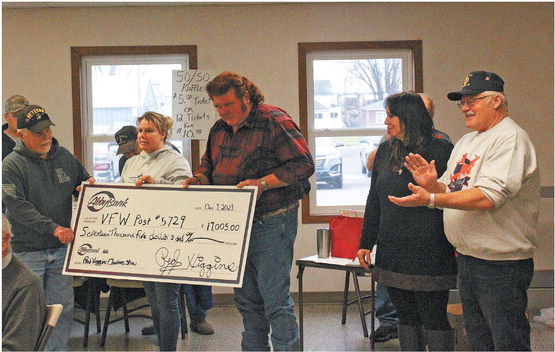Unity, RR agree to close three crossings
By Kevin O’Brien With hopes of keeping a railroad crossing open at Basswood Avenue, town of Unity officials have agreed to permanently close three other rail crossings that have been identified as potentially dangerous intersections for motorists.
At a July 30 public hearing hosted by the Office of the Commissioner of Railroads (OCR), attorney Dean Dietrich told administrative law judge David Albino that the town has agreed to close the railroad crossings at Badger Avenue, First Avenue and Sandhill Avenue, but town officials would still like to keep the Basswood crossing open.
Dietrich, who was hired by the town of Unity earlier this year to handle its dispute with the OCR, said Wisconsin Central Ltd. and the Wisconsin Department of Transportation have agreed to the town’s offer to close the three crossings. WCL has asked that all four crossings be closed, and at a special town board meeting on June 27, local residents in attendance voted to close Badger and First avenues and keep open Sandhill and Basswood.
Prior to last week’s hearing, eight town residents submitted written comments regarding the proposed crossing closures. A few of those same residents also spoke at the July 30 virtual meeting, making it known why they wanted to keep one or more of the crossings open to vehicle traffic.
Since the town has voluntarily agreed to close the crossings at Sandhill, Badger and First avenues, last week’s hearing was really only about the fate of the Basswood crossing. However, Judge Albino said he wanted to hear public testimony about the other three crossings “just for the record.”
Shannon Grewe, a town resident who lives on Badger Avenue, said he has deep concerns about all three of the closures the town has agreed to, especially the one on Sandhill Avenue. That crossing has already been closed for several months, rerouting traffic into the Riplinger community, which Grewe said does not have the sidewalks and other infrastructure needed to keep children and other pedestrians safe.
“The potential for tragic accidents is unacceptably high,” he said, adding that it’s “only a matter of time” before someone is seri-
See CROSSINGS/ Page 6 Crossings
Continued from page 1
ously injured or killed.
Grewe said closing the crossings will also slow down response times for ambulances and other emergency responders and create a financial burden for farmers who will have to drive farther when transporting their products and machinery. He said the area’s Amish residents, who travel by horse and buggy, will also be put at greater risk due to the rerouting of traffic.
Directing more traffic to the crossing at Century Road, which has been identified as a potential alternative route for crosstown traffic, would make the safety problems worse because of the slope near the crossing, he said.
“This decision will affect generations,” he said. “We need to get it right.”
In comments submitted online, Jim Dietsche, owner of Dietsche Family Farms on Meridian Avenue, said his family owns 160 acres just north of the Basswood Avenue crossing, and closing the crossing would have a detrimental impact on his operation, which relies on the use of heavy machinery.
“We routinely travel from State Highway 98 onto Basswood Avenue to access our land,” he wrote. “If Basswood Avenue were to be closed, it would result in significant financial losses due to increased fuel consumption, labor costs, and wear and tear on our equipment. Additionally, rerouting our large machinery through alternative routes would be more dangerous, increasing the risk of accidents and delays.”
At last week’s hearing, Dietsche spoke against the use of the crossing at Century Road, accusing the railroad of not keeping the crossing clear of obstructions.
“They leave their crossings with very, very poor visibility,” he said.
Richard Bruss, a farmer who lives on Basswood Avenue, expressed similar concerns about having to travel a longer distance to haul grain to Loyal and about the safety of the Century Road crossing.
“It is downhill to the tracks from both directions,” he wrote. “There would be no way to stop a loaded truck or even a car on those slippery slopes.”
Scott Johnson, another Basswood Avenue resident, wondered what kind of “protection” the town would get after closing the three crossings. He said residents already have to put up with loud train horns, and he would like to know about petitioning for a quiet zone in the area. Judge Albino said the OCR normally does not commit funds to upgrade crossings so they are eligible for quiet zones, so that cost would fall on the town of Unity.
Rep. Karen Hurd, who is running to represent the town of Unity in the State Assembly, also spoke at the July 30 hearing, saying that agriculture is a vital industry for the state that needs to be supported. She also noted that Clark County has the highest number of collisions between motor vehicle and horse-drawn buggies in the state.
“Rerouting traffic only adds to that problem,” she said.
After the public testimony portion of the hearing, Dietrich and Audrey Lane, an attorney for the railroad company, had an opportunity to question Greg Worzalla, a former OCR inspector who conducted studies on the crossing closures, and Wayne Hendrickson, longtime town chairman in the town of Unity.
Under questioning by Dietrich, Worzalla confirmed that the safety of the Basswood crossing could be improved by regular road grading and the trimming of trees and brush by the railroad company. He also acknowledged that no accidents had occurred at the crossing in recent times, but he said the potential is still high due to the speed of the trains and motor vehicles traveling through the intersection.
“A lack of crashes does not necessarily equate to the crossing being safe,” he said.
Hendrickson testified about the nature of agriculture in the town and also said that local emergency responders would have to be educated about the crossing closures so they know where they can and can’t go. He spoke in favor of keeping Basswood open as an option for north-south traffic, calling it a “clear-cut crossing” with good visibility.
“When you start up that hill, you can see just about all the way to Riplinger,” he said.
Before the hearing was closed, Judge Albino gave the town and the DOT until Aug. 9 to finalize their agreement in writing for closing the three crossings and to present to the railroad, which will then have until Aug. 19 to submit a joint filing to the OCR. Judge Albino said he doesn’t want any uncertainty about how much the DOT will pay the town for closing the crossings.
“I don’t want the town to somehow miss out on the opportunity to get incentive payments for their voluntary closures,” he said.
The dispute over the town of Unity’s railroad crossings goes back to 2013, when the OCR opened an investigation into the adequacy of warning devices at four different crossings. Ten years later, the investigation was expanded to include three other crossings. On-site inspections revealed several safety and noncompliance issues at the Sandhill and Badger crossings, and in November of 2023, the town was ordered to take several steps to fix the problems.
Despite efforts by town residents to clear brush from the Sandhill crossing area, the town board volunteered to close it, along with one at First Avenue in Riplinger.
Since 1973, two people have been killed in train-car collisions at the Sandhill crossing, and one other person was killed at the Badger crossing, according to state records.



